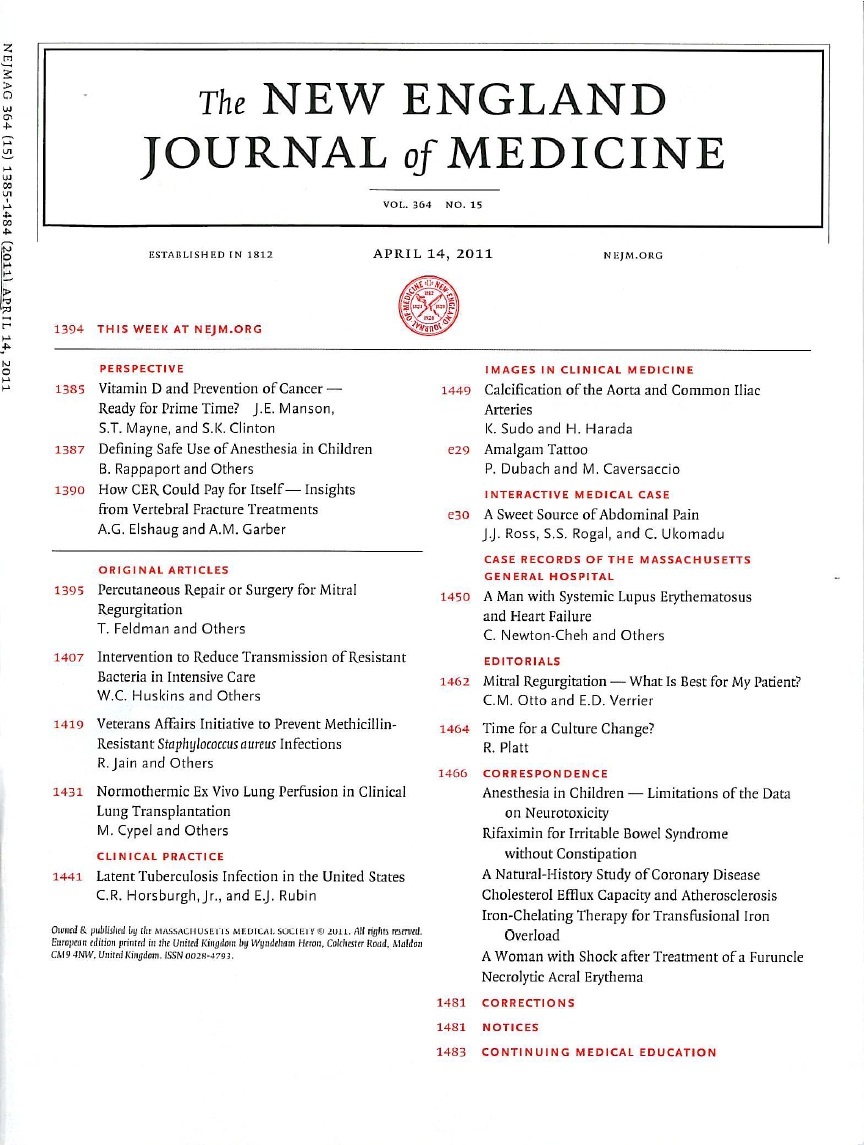
Oral vs. Intravenous Antibiotics for Bone and Joint Infection

Oral vs. Intravenous Antibiotics for Bone and Joint Infection
Oral versus Intravenous Antibiotics for Bone and Joint Infection
N Engl J Med. 2019 Jan 31;380(5): 425-436.Synopsis
1054 patients being treated for bone or joint infection at 26 UK centers were randomized in this non-inferiority trial to receive 6 weeks of oral antibiotic therapy (n=527) or 6 weeks of intravenous antibiotic therapy (n=527). The primary outcome of interest was the rate of definite treatment failure. Secondary outcomes of interest included the rate of treatment discontinuation, catheter complications, diarrhea caused by C.difficile, serious adverse events, length of hospitalization, and patient-reported outcomes (Oxford Hip and Knee Scores [OHS; OKS]; EuroQual-5Dimension scores [EQ-5D]). Outcomes were assessed at 6 weeks, 4 months, and 1 year follow-up. Oral antibiotics were found to be non-inferior to intravenous antibiotics with regards to the risk of definitive treatment failure. The incidence of early discontinuation of treatment and catheter complications, and length of hospitalization were significantly higher in the intravenous group, however, no differences in the incidence of diarrhea or serious adverse events were observed between the two groups. EQ-5D scores and OHS scores were not significantly different between groups at 4 months and 1 year post-treatment, however, OKS scores were better in the oral group at both time points.
Publication Funding Details
Why was this study needed now?
Patients with bone and joint infection require prolonged antibiotic treatment, which is frequently delivered intravenously. However, the use of intravenous antibiotics has been associated with additional complications and higher costs vs. oral antibiotics. Therefore, it is of interest to determine whether oral antibiotics can provide an non-inferior management of bone and joint infection.
What was the principal research question?
In patients with acute or chronic bone/joint infection, is oral antibiotic therapy non-inferior to intravenous antibiotic therapy with respect to treatment success, within 1 year post-randomization?
What were the important study characteristics?
1054
Total Sample Size
527
Antibiotics (Oral)
527
Antibiotics (Intravenous)
Serious Adverse Events
Lower = Better
Randomized Controlled Trial
Locations: United Kingdom
Outcomes: Serious Adverse Events
What were the important findings?
Oral antibiotics were found to be non-inferior to intravenous antibiotics with regards to the risk of definitive treatment failure. The incidence of early discontinuation of treatment and catheter complications, as well as length of hospitalization, were significantly higher in the intravenous group, however, no difference in the incidence of C.difficile-associated diarrhea was observed between the two groups. EQ-5D scores and OHS scores were not significantly different between groups at 4 months and 1 year post-treatment, however, OKS scores were better in the oral group at both time points.

1 Years


Risk of Bias
 Was the allocation sequence adequately generated?
Was the allocation sequence adequately generated?
 Was allocation adequately concealed?
Was allocation adequately concealed?
 Blinding Healthcare Professionals: Was knowledge of the allocated interventions adequately prevented?
Blinding Healthcare Professionals: Was knowledge of the allocated interventions adequately prevented?
 Blinding Outcome Assessors: Was knowledge of the allocated interventions adequately prevented?
Blinding Outcome Assessors: Was knowledge of the allocated interventions adequately prevented?
 Blinding Patients: Was knowledge of the allocated interventions adequately prevented?
Blinding Patients: Was knowledge of the allocated interventions adequately prevented?
 Was loss to follow-up (missing outcome data) infrequent?
Was loss to follow-up (missing outcome data) infrequent?
 Are reports of the study free of suggestion of selective outcome reporting?
Are reports of the study free of suggestion of selective outcome reporting?
 Overall risk of bias
Overall risk of bias



Risk of Bias
 Was the allocation sequence adequately generated?
Was the allocation sequence adequately generated?
 Was allocation adequately concealed?
Was allocation adequately concealed?
 Blinding Healthcare Professionals: Was knowledge of the allocated interventions adequately prevented?
Blinding Healthcare Professionals: Was knowledge of the allocated interventions adequately prevented?
 Blinding Outcome Assessors: Was knowledge of the allocated interventions adequately prevented?
Blinding Outcome Assessors: Was knowledge of the allocated interventions adequately prevented?
 Blinding Patients: Was knowledge of the allocated interventions adequately prevented?
Blinding Patients: Was knowledge of the allocated interventions adequately prevented?
 Was loss to follow-up (missing outcome data) infrequent?
Was loss to follow-up (missing outcome data) infrequent?
 Are reports of the study free of suggestion of selective outcome reporting?
Are reports of the study free of suggestion of selective outcome reporting?
 Overall risk of bias
Overall risk of bias
What should I remember most and how will this affect the care of my patients?
The results of this study suggest that oral antibiotics are non-inferior to intravenous antibiotics for the management of bone and joint infection, as measured by treatment failure. Moreover, oral antibiotics are associated with a shorter length of stay and fewer complications compared to intravenous treatment. This study was limited by the open label design and potential differences in follow-on treatment. This study challenges the widely accepted standard use of intravenous antibiotics for bone/joint infection.
Learn about our AI Driven
High Impact Search Feature
Our AI driven High Impact metric calculates the impact an article will have by considering both the publishing journal and the content of the article itself. Built using the latest advances in natural language processing, OE High Impact predicts an article’s future number of citations better than impact factor alone.
Continue



 LOGIN
LOGIN

Join the Conversation
Please Login or Join to leave comments.